There was a time when layering skincare was simple. You cleansed, you toned, and you moisturized. In the daytime, you added sunscreen on top.
So, where does the serum go? And which serum goes on first? What about essences? And spot treatments? And face oils?
When did it get complicated? Why does it matter? What happens when you get the order of your skincare products wrong? And what is the right way to layering skincare products?
Here is the most effective, no-fripperies (if I may say so) intelligent guide you shall find to all these questions.
Because. It. Matters.
Why does the order of your skincare products matter?
Have you ever tried to put jam on toast first, then the butter? Did it work for you? Or did the butter just sit on the jam rather than soaking into the bread, and everything was one big gooey mess?
That’s what happens with skincare. Let’s take a look:
— If you put on a thicker product before one with a thinner consistency, the former will create a barrier over your skin. This means the product with the thinner consistency won’t reach where it needs to for effective results. For instance, layering serum over a face oil will make the latter useless.
— Ditto for oil- and water-based formulations. Water cannot cut through oil, so the water-based creams or serums must go on first if they have to do their work.
— Layering your skincare products correctly makes sure that active ingredients have the chance to work properly. Hyaluronic acid? It needs to go under a moisturizer. Spot treatment? After the serums.
So, properly layering skincare products is all about making your routine most effective and not rendering any of those precious lotions and potions useless.
With that established, let’s discuss each element individually (with the understanding that we are putting everything on a freshly cleansed face!). Here’s your ultimate guide on how to layer skincare products.
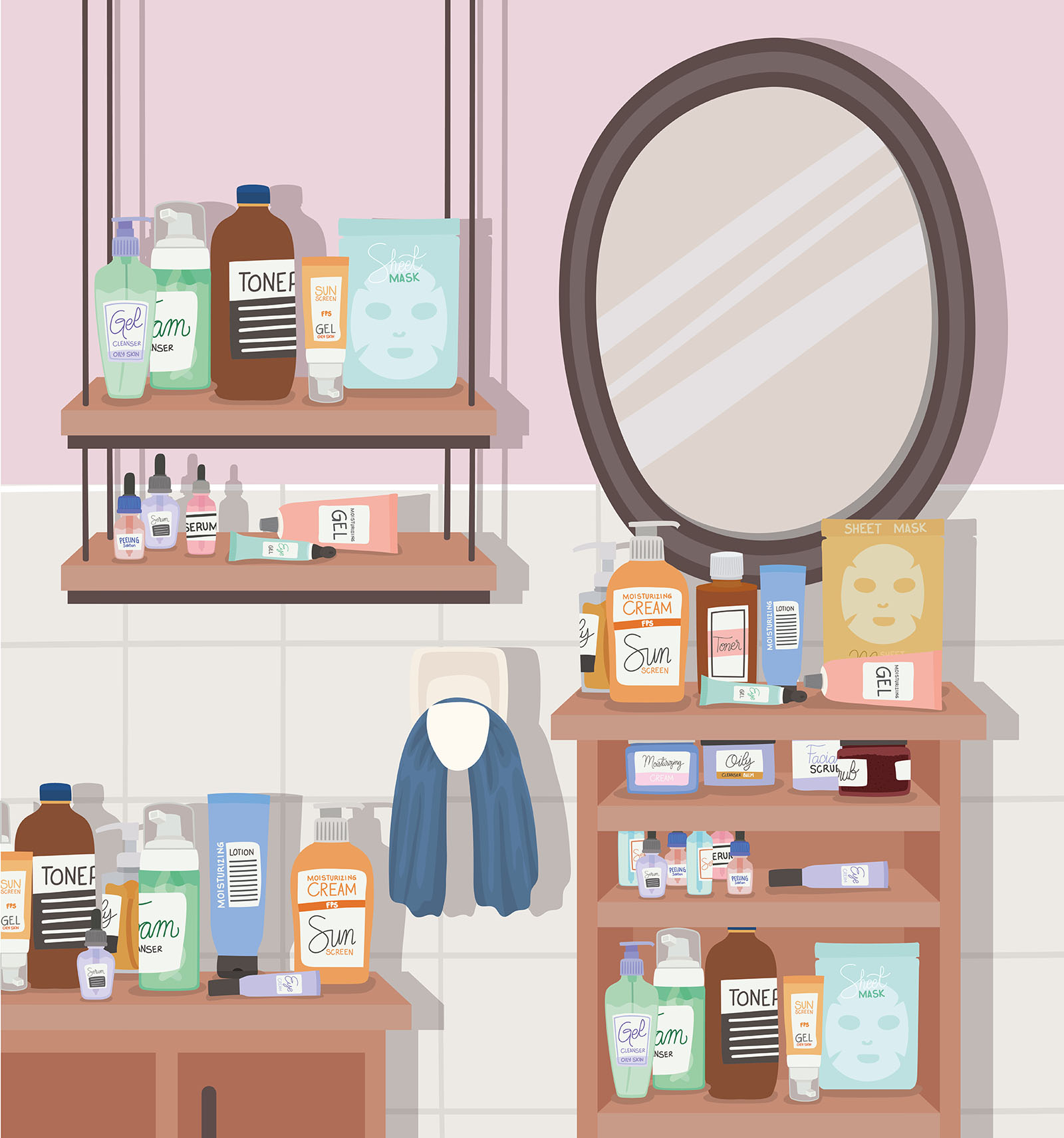
Toners and essences
Whether or not we should still be using toners is a loaded topic and deserves its own blog post.
At the moment, we are focusing on layering skincare products — and in that context, if you use a toner, it should be the first thing that goes on to freshly cleansed skin.
Ditto for essences.
If you are using both, the toner will go on first… then wait about 60 seconds and pat on the essence.
That’s because both toners and essences are the thinnest products in your routine, and their primary purpose is to soften the skin so other products can be absorbed more easily.
Eye cream
This was a revelation to me — every single expert I spoke to for this piece on how to layer face products insisted that eye cream needs to go on before any other skincare.
This is necessary to protect the delicate undereye area from potent ingredients that could cause irritation.
Serum(s)
Serums are super-concentrated treatments that address specific complexion concerns. They are loaded with actives and nutrients that need to sink into the skin.
Hence, serums usually have a super-light consistency to allow for easy absorption.
Given all this, serums must go on before any occlusive (barrier-forming) product so that they sit right next to the skin.
If you skip the former, this makes them the second step after toners and essences or the first step in your skincare.
But… what happens when you are using more than one serum?
In that case, the rule of texture and consistency applies: The thinner serum goes before the thicker one (pour a couple of drops on your hand to check each one); the water-based serum goes before the oil-based one (read the ingredient label).
And, if both serums have the same consistency and texture, apply the one your skin needs the most first. So, if your biggest concern is acne, the salicylic acid goes on first. Or if you want to deal with hyperpigmentation as a priority, it will be the serum with Vitamin C.
Another rule of thumb: Wait a minute between putting on each serum. This way, you will allow them to absorb fully and stop pilling.

Spot treatments
Next in how to layer face products come the spot treatments — the benzoyl peroxide for acne, the zit stickers, and the calamine-based formulations.
These will come after the serums and before the moisturizers.
Moisturizers
Nowadays, moisturizers are being used for various skin concerns, including hyperpigmentation and fine lines. However, their main function is to provide the skin with hydration and form a protective layer to retain the benefits of your other skincare products.
Hence, they go on after everything else. Always.
Unless you are putting on a sleeping mask at night, in which case it would simply replace the moisturizer.
Face oils
Face oils are lovely and work wonders for undernourished or super-dry skin — when used correctly.
If you use only a face oil, it replaces the moisturizer.
If you wear both, the face oil goes on top of the moisturizer. That’s because most face oils can penetrate a moisturizer but not vice-versa.
The best option, though, is to alternate. Wear a more lightweight moisturizer in the daytime and a face oil at night. However, that depends on your skin and preferences.
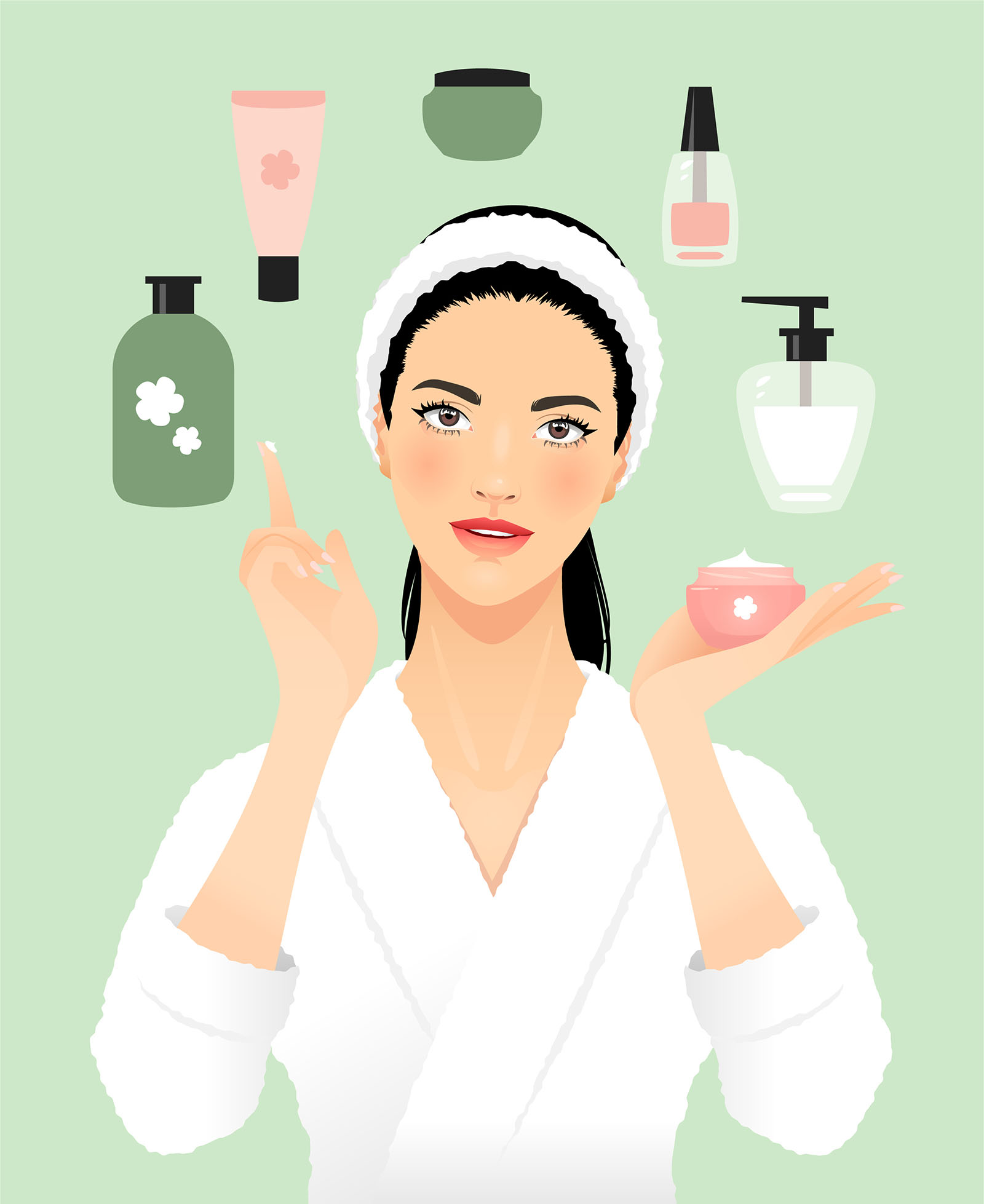
Finally: The sunscreen
In today’s age, you have to be living under a rock to be oblivious to the importance of sunscreens. And while that would be an entirely independent blog post, here what’s important is where the sunscreen would go in your skincare routine.
The answer: This part of layering skincare depends on whether you use a physical or chemical sunscreen.
Check the label — the formula is chemical if it lists Parsol, mexoryl, oxybenzone, or avobenzone as an ingredient.
Suppose it contains none of these and lists zinc oxide or titanium dioxide? In that case, it’s a physical sunscreen (also known as sunblock).
If it contains ingredients from both categories, treat it as a chemical sunscreen.
Chemical sunscreens need to sink into the skin, so they go on before the moisturizer.
However, since layering on a moisturizer over sunscreen can sometimes get messy (think pilling and patchiness), try to look for a hydrating SPF formula that can double up as the moisturizer.
On the other hand, physical sunscreens create an opaque barrier on your skin. They won’t allow any other product to work effectively over them.
So, if you put moisturizer over sunblock, the latter will stop the former from being effective. And that is precisely why you need to understand how to layer face products.
Plus, putting on the moisturizer or serum over the physical formulation can give the sunblock a patchy effect, reducing sun protection. This makes it crucial that physical sunscreen is the last step in your (daytime) skincare routine.
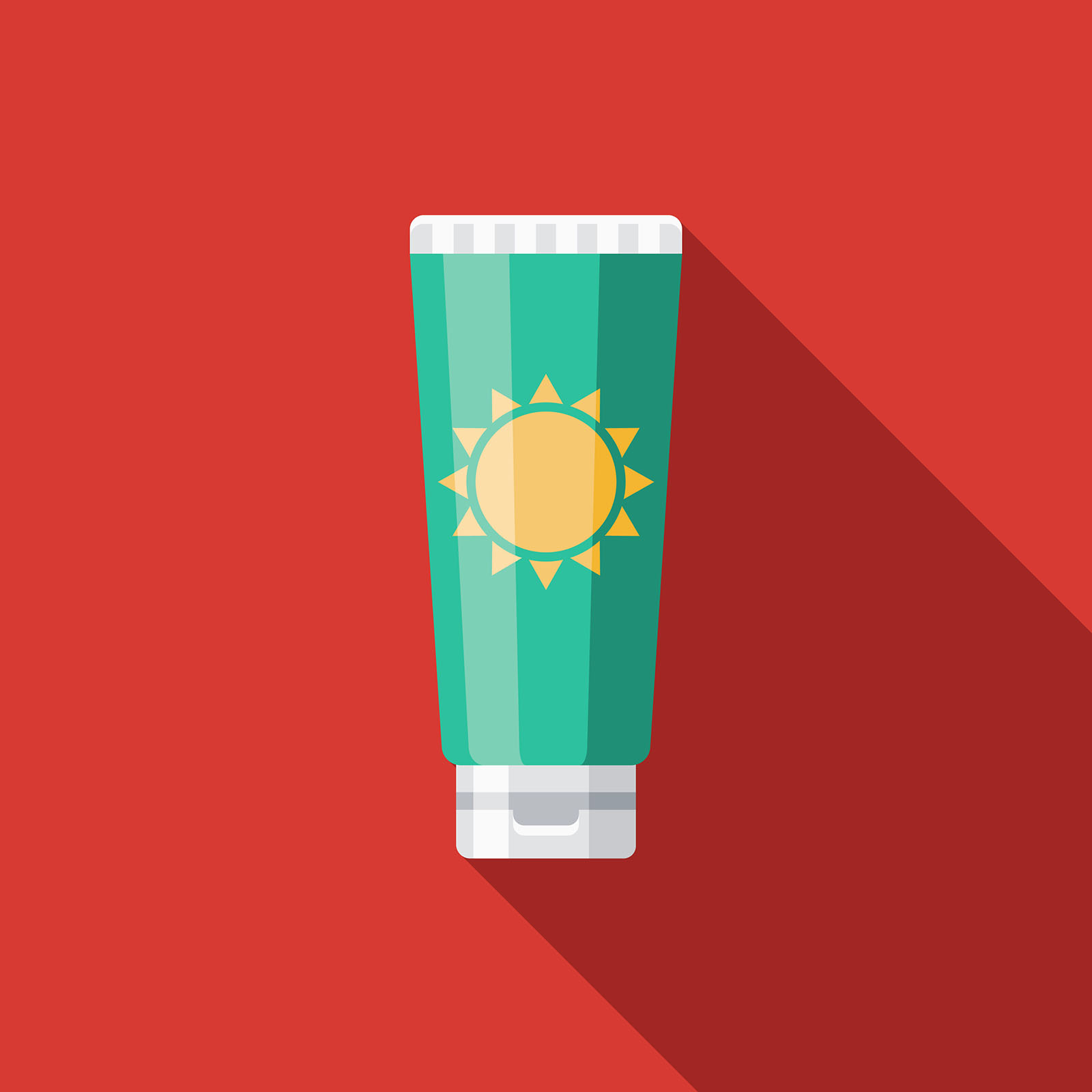
Makeup?
Any makeup — like foundation, concealer, and powder — would go on last in all cases.
Unless you’re using a powder sunscreen (check out the best powder sunscreens here!), which can be brushed on right at the end instead of setting powder.
Powder sunscreens are usually mineral based and won’t clog the pores, making them perfect for those with acne-prone skin.
An added benefit: You can reapply every couple of hours (as you know you’re supposed to be doing!) without disturbing your makeup.
FAQs
Here are 10 frequently asked questions about layering serum, moisturizer, and sunscreen. If you want more information, drop it in the comments below, and I will get the answers ASAP!
What is the correct order for applying serum, moisturizer, and sunscreen?
The correct order is serum first, then moisturizer, and finally, sunscreen. Each layer serves a purpose, and this order helps ensure all of them work effectively.
Can I use different brands for my serum, moisturizer, and sunscreen?
Absolutely. You can mix brands as long as the products are suitable for your skin type and don’t cause any adverse reactions when used together.
Should I apply sunscreen or serum first?
For the most effective skincare routine, follow this non-negotiable order: serum first, then sunscreen. Serums are lightweight formulas packed with highly concentrated active ingredients designed for absorption deep into the skin. Applying serum first ensures these active ingredients are fully absorbed.
In contrast, sunscreen forms a protective layer on your skin, guarding against harmful UV rays. If applied first, this protective layer could block the absorption of any skincare products used afterward. Thus, sunscreen after serum ensures the serum’s ingredients are not blocked and your skin receives the highest sun protection. This strategy results in a radiant complexion with optimal protection.
Why should serum be applied before sunscreen?
The main reason is that serum is designed to be absorbed deeply into the skin and has smaller molecules than sunscreen. So, applying sunscreen first can create a barrier that prevents the serum from penetrating effectively.
Is it okay to mix serum, moisturizer, and sunscreen and apply them all at once?
It’s not recommended. Each product is formulated to perform best when applied separately. Mixing could dilute their effectiveness and alter the individual benefits.
Should I apply sunscreen or serum first?
While layering skincare products, apply from thinnest to thickest consistency. Therefore, you should apply serum first because it has a lighter texture and is designed to penetrate deeper into your skin. On the other hand, sunscreen creates a barrier over the skin to protect it from harmful UV rays, so it should be applied last.
Should I wait between applying serum, moisturizer, and sunscreen?
Yes, it’s generally good to wait for about a minute between each step to allow each product to fully absorb into the skin.

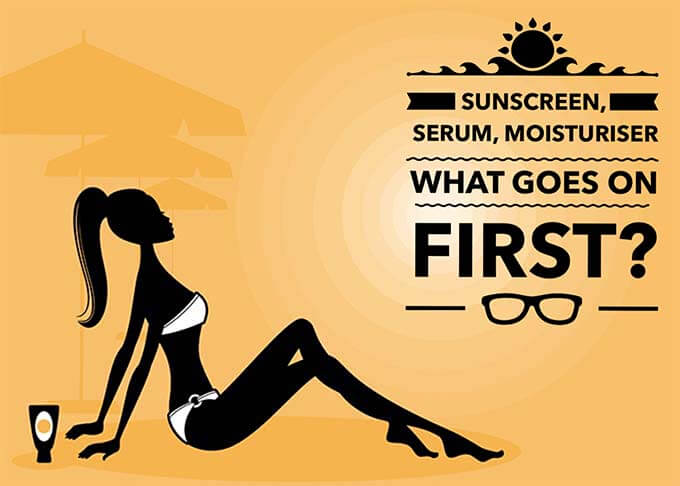
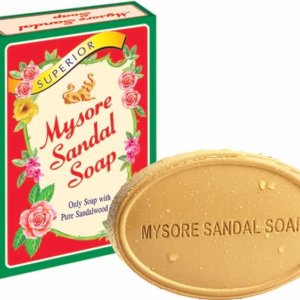

RAJESH THOMAS says
after shaving can i use ECO AROMA LAVENDER ESSENTIAL OIL & THEN APPLY SUNSCREEN ULTRA PROTECT SPF 50-PRODUCT IS BANANA BOAT?
AWAITING FOR YOUR VALUABLE SUGGESTION.
Apoorva Aggarwal says
With the summers here I have bought a sunscreen serum for face and now was wondering when is the right time to apply. Thanks for writing this blog and instructing the correct way to use it. Keep up the good work.
Sophie says
Hello, I am a little confused with the order you provided regarding sunscreens. You mentioned that if the person is using chemical sunscreen they should apply the sunscreen first? This was not on my sunscreen instruction. I am using a chemical sunscreen but the filters are not from the US but came from Korea. I was always instructed by my dermatologist that sunscreens of any sort must go on last unless you’re using a foundation then that would be the last the thing to put on. But never heard or been told that chemical sunscreen goes on first then follow by serum and moisturizer. This is a very interesting concept.
Nerdle says
Because oil can act as a barrier against water, using a moisturizer containing oil prior to applying a water-based serum can prevent the skin from taking in the active chemicals in the serum. One more explanation for this difference is because moisturizers often have larger molecular structures than serums do. Because of this, they are able to deliver the chemicals to more deeply into the skin.
online iptv says
I think it’s important to layer your skincare products to get the best results. For example, if you’re using a serum, you might also want to use a sunscreen on top.